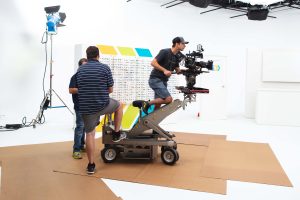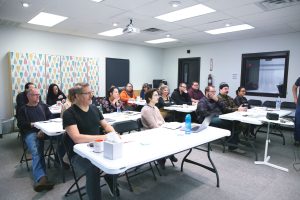Set aside for the moment that AI tools can be used to spawn massive volumes of garbage content designed to choke the life out of the internet. For the purposes of this post let’s assume your aim is true and you’re just looking for a little digital assist. Chat GPT and its large language model brethren can indeed be used for good, as I discovered firsthand struggling to meet an important deadline.
Backstory
The company where I work, AMP Creative, generates digital content for a wide array of verticals from marketing to education and beyond. One of our most successful recent projects involved the creation of a virtual reality experience designed to enhance the accessibility of a popular museum exhibit. The Plano Interurban Railway Museum owns a rare piece of Texas history, one of the last railroad cars that rode a fully electric transit line back in the early half of the 20th century.

Car 360 is open for citizens of North Texas to tour, propelling guests back in time to a day when vast systems of track carried mail, passengers and even old film reels from downtown Dallas to Waco and back. Unfortunately, the car was constructed in an era long before accessibility concerns were given much consideration. As a result, the narrow confines of Car 360 were off limits to many potential guests who are differently abled. Not content with the status quo, the staff of the Interurban Railway Museum tapped AMP to create a VR tour that would not only allow all attendees to enjoy the interior of the train but allow portable headsets to be shared outside the walls of the museum with anyone unable to access their physical location.

The success of that project opened the door for me to deliver a presentation on XR for Accessibility at the 2023 Texas Association of Museums conference. Unfortunately, my daily workload can’t be easily put on hold for the extra tasks needed to give a polished presentation, and slide decks don’t create themselves. At least not until now. Excited by the TAM opportunity, but with other deadlines competing for my attention, it seemed like a good time to wade into the frothy waters of generative AI and see if I could get a quick efficiency boost. Here’s a few examples of how the chatbot revolution helped me satisfy all my competing responsibilities.
A Partner in the Battle Against the Blank Page
My first stop on the yellow brick road of AI was a visit to ChatGPT. A case study detailing AMP’s work on the Interurban Railway project provides the backbone of my TAM presentation. Still, I wanted to expand the scope of my talk to include the larger world of accessibility that’s being unlocked using extended reality technology, or XR, at other museums and exhibition spaces. Normally this would take some research requiring Google-jitsu that sometimes produces quality results in a single search, but can also take hours of search, cross referencing, and re-search that still ends in a frustrating collection of bogus links. For example, I queried Google with the straightforward “using VR for accessibility in museums”. What came back leaned heavily on general examples of VR use in the museum community. Using ChatGPT however was more like opening a dialog with a skilled librarian. While I started with the same general prompt, I was able to refine the reference materials I received by engaging in a conversation of sorts with ChatGPT. The resulting draft was competently structured (professional if not stylish) and included information on new technologies like haptic gloves that allow sightless patrons to “feel” the contours of famous artworks, and virtual spaces capable of generating real time dynamic captions for the hearing impaired. My results also included a collection of reference links that allowed me to quickly do follow up research to verify the accuracy of the content.
That last part is important, because spoiler alert, if you haven’t already heard the news, this new wave of chatbots, however well trained, still freely fabricate information. So blanket warning to any shifty high schoolers who think a couple down and dirty prompts are going to result in a passing thesis paper. We’re not quite there yet. But that said, ChatGPT did make a valuable ally when it came to beating back the existential dread of staring at a blank page.
A Picture Worth a Thousand words (in 10 words or less)
AI powered Text-to-Image tools have been around for a while now, and in a lot of ways they’re the easiest ones to wrap your brain around. Dalle-E and MidJourney are now infamous in creative circles, thought of as a Godsend by some, and synonymous with curse words for others. Dozens of Text-to-Image imitators have sprung up in their shadows, but these 2 platforms are definitely OG AI. However, Adobe is jumping on the bandwagon with their new #Firefly toolset, currently in beta. Many of these generative image platforms understandably draw the ire of artists over issues of copyright violation or outright theft. #Firelfy on the other hand is said to be trained on a data set of fully licensed images owned by Adobe, something to think about when this creative cloud solution becomes publicly available.
Under many circumstances good old fashioned stock photos are perfectly suited to the task of populating a PowerPoint deck, but I wanted something very specific, a sci-fi Choo-choo traveling warp speed into the future.

No offense to Shutterstock, but not every product of my fevered imagination is available in their otherwise impressive catalog. So, I prompted MidJourney to create an iteration of this visual that I could use in a crucial section of the deck. I was feeling sassy, so I went on to solicit a cyber punk passenger to cheer the space train along its cosmic journey.

By feeding the generative AI a simple reference photo of the real Car 360, and pairing it with a collection of illustrative instructions, in this case “Hyper real cyberpunk train flying through space with motion lines.” MidJourney then offers up 4 options, which you can either select for up res, or request iterations of your favorite versions and evolve the image further towards one that works for your specific needs. You can see my final selections below.
What lies ahead
These are just a few rudimentary examples of how AI tools not only knocked hours off my workload, but arguably provided me with original content I wouldn’t have had access to through traditional methods. But the market is quickly becoming saturated with tools designed to leverage AI technology for the specific purpose of creating, or improving, presentation decks. A platform like Deck Robot will allow you to upload your existing draft, then customize it to generate a final product by instantly swapping out fonts, colors, and design elements. Other platforms, like Design.AI, ask that you simply upload text, then sit back and watch as a variety of design options are generated for you to choose from. Of course, these services all come with a price tag, and you can expect to pay anywhere from 10’s to 100’s of dollars per month for the best available features. While you comparison shop, be mindful that many of these emergent platforms have probably just shoe-horned the letters “AI” into the title of their existing products regardless of how much artificial intelligence is actually being deployed since that’s the new trendy, gold rush marketing phrase. Yesterday’s opportunistic crop of mover/shaker metaverse experts have all rebranded themselves as AI gurus and prompt engineers. So as with all things, caveat emptor. But if your hype radar is properly deployed, there are many genuine benefits to be gained from this remarkable new suite of innovative AI assistants.
















